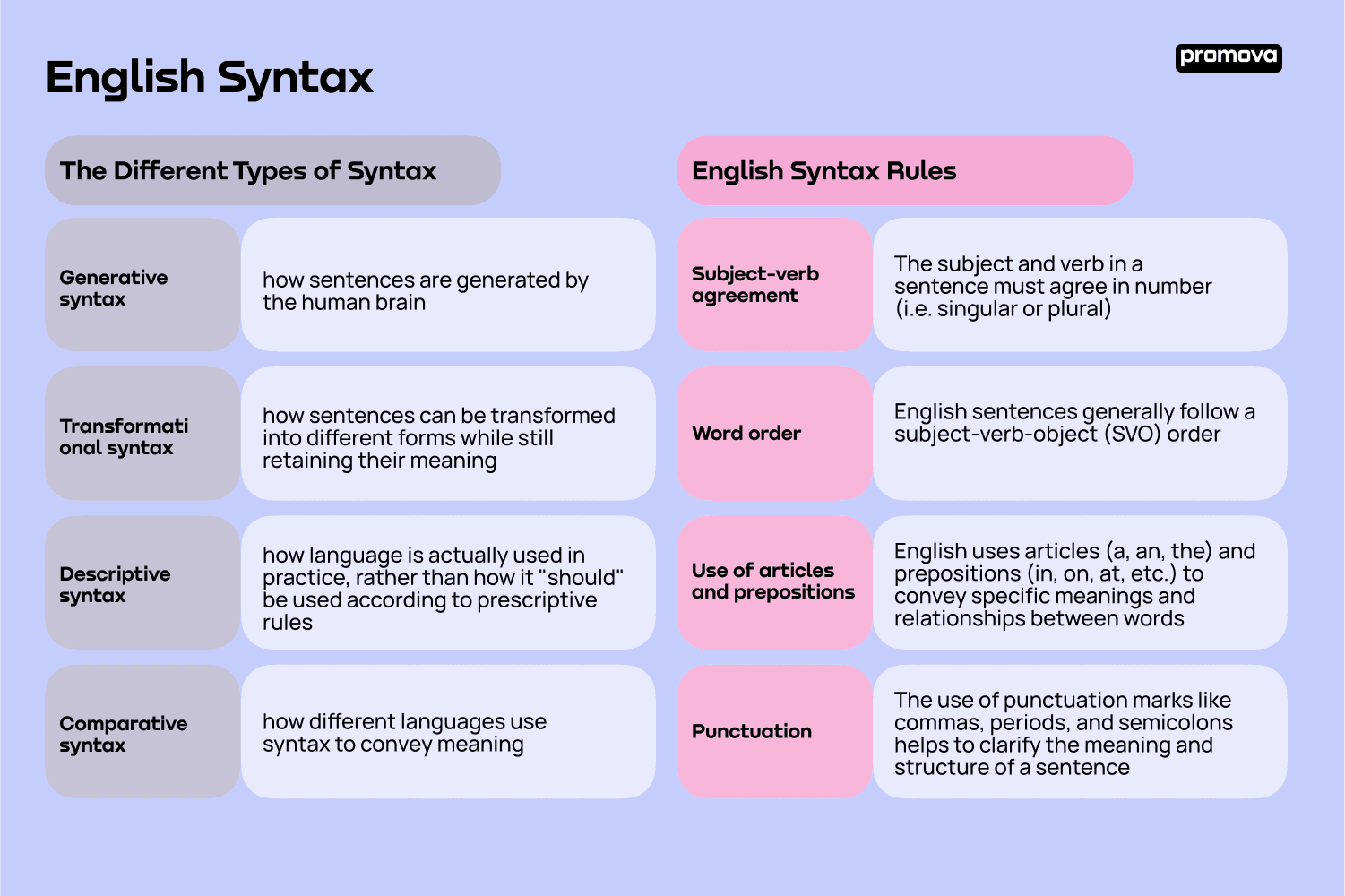English Syntax
Contents
If you're reading this, chances are you're learning to speak English and want to get better. So, have you ever stopped to think about what makes English language work? What is it that allows you to string words together in ways that make sense? The answer is syntax. It's not the most fun part of the language, but it's quite interesting to learn with the right approach!

Understanding Syntax
So what exactly is syntax? At its most basic level, syntax is the set of rules that govern how we put words together to form sentences. It covers everything from word order to punctuation to the use of articles and prepositions. Without syntax, language would be chaos - a jumbled mess of words that don't make any sense.
Syntax is part of what makes language so powerful. It allows us to convey complex ideas and emotions through the use of words. By following the rules of syntax, we're able to communicate clearly and effectively.
The role of Syntax in language
Syntax is crucial to language for several reasons.
- It allows us to understand the meaning of what we're reading or hearing. Without syntax, words would be nothing more than random sounds or symbols.
- Syntax gives them structure and context, allowing us to interpret their meaning.
- By following the rules of syntax, we're able to convey our thoughts and ideas clearly and coherently. This is particularly important in fields like business, education, and politics, where effective communication is essential.
The Different Types of Syntax
There are several different types of syntax, each with its own set of rules and conventions.
- Generative syntax: This is the study of how sentences are generated by the human brain.
- Transformational syntax: This is the study of how sentences can be transformed into different forms while still retaining their meaning.
- Descriptive syntax: This is the study of how language is actually used in practice, rather than how it "should" be used according to prescriptive rules.
- Comparative syntax: This is the study of how different languages use syntax to convey meaning.
English Syntax Rules
English syntax is governed by a set of rules that dictate how words should be arranged to form sentences.
- Subject-verb agreement: The subject and verb in a sentence must agree in number (i.e. singular or plural).
- Word order: English sentences generally follow a subject-verb-object (SVO) order, although this can vary depending on the context and intended meaning.
- Use of articles and prepositions: English uses articles (a, an, the) and prepositions (in, on, at, etc.) to convey specific meanings and relationships between words.
- Punctuation: The use of punctuation marks like commas, periods, and semicolons helps to clarify the meaning and structure of a sentence.
Examples of Correct Syntax
Here are a few examples of correct syntax in English:
- The cat sat on the mat.
- She is studying for her exams.
- They went to the store to buy some groceries.
In each of these sentences, the words are arranged in a way that makes sense and follows the rules of English syntax.
Common Mistakes in English Syntax
Of course, not everyone gets English syntax right all the time. Here are some common mistakes to watch out for:
- Subject-verb disagreement: "The group of students is" (incorrect) vs. "The group of students are" (correct).
- Misplaced modifiers: "Running through the park, John's dog chased a ball" (incorrect) vs. "John's dog chased a ball while running through the park" (correct).
- Incomplete sentences: "Because I was tired" (incorrect) vs. "Because I was tired, I went to bed early" (correct).
1
Syntax in Writing vs. Speaking
Syntax plays a slightly different role in writing than it does in speaking. When we write, we have more time to carefully choose and arrange our words, so we can craft more complex and nuanced sentences. We can also use punctuation and formatting to help convey our intended meaning.
In speaking, however, we often have to think on our feet and come up with sentences on the fly. This means that our syntax may be more simple and straightforward, as we don't have the luxury of taking our time to craft the perfect sentence.
Syntax in Literature and Poetry
Syntax plays a particularly important role in literature and poetry. Writers and poets use syntax to create rhythm, convey emotion, and evoke specific moods and images.
For example, consider the following lines from William Wordsworth's poem "I Wandered Lonely as a Cloud":
"I wandered lonely as a cloud That floats on high o'er vales and hills, When all at once I saw a crowd, A host, of golden daffodils"
Here, the syntax creates a sense of movement and flow, echoing the gentle swaying of the daffodils in the breeze.
Fun Facts About Syntax
- The word "syntax" comes from the Greek word "syntaxis," which means "arrangement."
- Syntax is among the oldest branches of linguistics, going back to the ancient Greeks and Romans.
- Syntax can vary widely between languages. For example, while English generally follows a SVO word order, Japanese often uses a SOV (subject-object-verb) word order.
Summary
Syntax is a fundamental aspect of language that allows us to communicate effectively and convey complex ideas. By understanding the rules of English syntax, we can improve our writing and speaking skills, and avoid common mistakes. Whether you're a writer, a student, or just someone who loves language, taking the time to learn about syntax can help you appreciate the beauty and power of words. Good luck on your language journey and make sure to check out more handy references below!
Comments